History of Sodick
Part 1: Founding and Before to Phase of Technical Development &
Remarkable Growth
Phase of Technical Development & Remarkable Growth (1980 onwards)
Following a growth trajectory
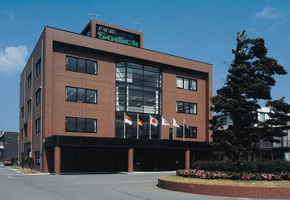
Fukui Plant at the time of completion
(Fukui Office)
Following the release of its NC EDMs, Sodick's sales grew steadily. But to further increase its sales and compete with the major EDM manufacturers, Sodick had to expand its own production facilities.
So in June 1980, Sodick completed the construction of a new plant that would become its main production base. The new Fukui Plant was conveniently located in Sakai Town, Sakai City in Fukui Prefecture, just one hour or less from the airport. The Fukui Plant was based on the "machines building machines" concept and was equipped with cutting-edge facilities from the outset. It allowed even people with no experience in building machines to produce EDMs with excellent precision.
At the same time, cooperating companies started manufacturing product components in the area around the Fukui Plant, ensuring security in the procurement of the parts needed for production. In this way, it was possible to build a mass-production system at the Fukui Plant early on.
In fact, this resulted in sales growing rapidly, from 700 million yen when the company was established in 1976, to 6.1 billion yen by 1981, the year after the Fukui Plant was opened. Growth was so strong the plant had to be expanded.
The strength of this growth led to the completion of the company's new head office building in Shin-Yokohama in October 1982. This was followed by the second and third stages of the Fukui Plant expansion, with sales rising to 10.6 billion yen by 1983 and 16.9 billion yen in 1985.
Then, in February 1986, just 10 years after the company was founded, Sodick became the first EDM manufacturer to be listed in the Second Section of Japan's stock market on the Tokyo Stock Exchange.
Thus, Sodick's commitment to ongoing R&D so as to address the needs of its customers was rewarded by this proof of the high regard for Sodick as a manufacturer of electrical discharge machines equipped with the latest in cutting-edge technology.

- You experienced dramatic growth in the years immediately after the company was launched. Tell us a little about that time.
-
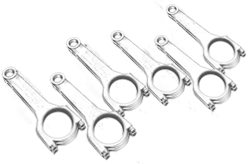 6-cylinder connecting rods
Furukawa
In those days, we were selling products as fast as we could make them. I think it was just that the world really needed them. What we made first was steel-forging molds for the connecting rods used in car engines. A 6-cylinder engine needed 6 connecting rods, and a 12-cylinder engine needed 12. Until then, producing large numbers of the same mold had been really hard work.
6-cylinder connecting rods
Furukawa
In those days, we were selling products as fast as we could make them. I think it was just that the world really needed them. What we made first was steel-forging molds for the connecting rods used in car engines. A 6-cylinder engine needed 6 connecting rods, and a 12-cylinder engine needed 12. Until then, producing large numbers of the same mold had been really hard work.
So the customer was really pleased when they could use EDMs with copper electrodes to make any number of forged steel molds
without using up the electrodes.
- I see that it was a real revolution in making molds.
- FurukawaEven today, I still think it was a ground-breaking moment.
To be able to machine a hard material like steel using something as soft as copper, without wearing out the electrode.
- Without EDM, what do you think would be happening today?
- Furukawa I think there wouldn't have been the sort of industrial growth we see in Japan now.
The discovery of machining without using up electrodes has spawned a host of new technologies.
The very first molds we made were for glasses, then the molds for connecting rods in cars, and the next were for the glass in car headlights.
Then, I was finally confident and thought “That's pretty good right there. They're the things that make a difference out in the world.”
Rapid Progresses on Developing New Techniques
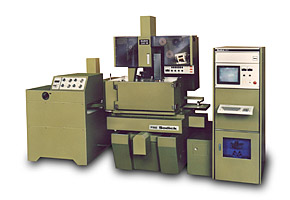
"330W" NC Wire-cut EDM capable of
concurrent 5-axis control
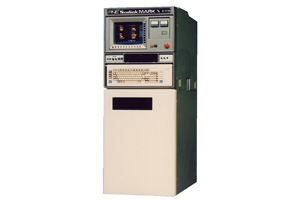
"MARK X" NC power supply unit
Sodick was also putting its energy into R&D for new technologies for products, pushing through so many trials and verification processes each day that the development staff were achieving one patent application per person per month.
When the Fukui Plant was completed in August 1980, they developed the "Assist" support software for NC die-sinker EDM, and in October of the same year developed the "PIKA-1" mirror-surface finishing circuit.
In January of the following year, they developed the "330W" NC Wire-cut EDM, which featured 5-axis control, making it possible to machine complex shapes that were not possible with conventional machines.
In January 1982, Sodick developed and started selling the "8133" power supply unit for EDMs, featuring a built-in 16-bit microcomputer. In March of that year, they developed "VITOL", a special high-performance machining fluid for EDM. And in April that year, they released the "A-series" NC die-sinker EDMs.
This was followed in March of the following year by the release of the new "MARK IV" and "MARK V" NC power supply units, providing the option of NC power supply units arranged in series. The following November, Sodick released an "NC die-sinker EDM with 4 numerically controlled axes plus a rotating main axis."
In September 1984, they developed and released the Small Hole EDM, which was followed in November by the "PIKA-2" ultra-fine finishing circuit for NC Wire-cut EDMs, the "A1C" NC die-sinker EDM, and the "MARK VII" NC power supply unit for wire-cut EDM.
New "EPOC"-series machines were released in February 1985, followed by the new "MARK X" and "MARK XI" NC power supply units, featuring interactive CRT displays capable of displaying kanji (Chinese characters).
In October 1986, Sodick released the "AP3S-ATC" NC die-sinker EDM featuring a 3D shape measurement function, the "DiPro X" automatic mold design and manufacturing system, and the "APM1" NC electrode milling machine. In August of the following year, they unveiled the A-series NC Wire-cut EDMs and the "Gold Type" "MARK X"-series NC power supply unit.
These products made an enormous contribution to manufacturing in Japan, and their technical excellence received high praise from all sectors.
In fiscal year 1981, the "PIKA-1" mirror-surface finishing circuit was awarded "the Invention Prize" by the Japan Society for the Advancement of Inventions, while the "VITOL" special high-performance machining fluid for EDM received "the Good Idea Prize" from the same organization in FY1982. In FY1983, Sodick received "the Promotion of Machine Industry Award" from the Japan Society for the "Promotion of Machine Industry for its development of the NC die-sinker EDM with 4 axes plus a rotating main axis". And in FY1988, the "A500" and "A350" NC Wire-cut EDMs were selected to receive "the Good Design Award" by the Ministry of Economy, Trade and Industry.
Through its ongoing effort to develop products that address the needs of its customers, Sodick has cemented its position as a pioneer of electrical discharge machining.

- What do you think were the factors behind the development of so much amazing technology?
- FurukawaMaybe it was me hassling them persistently all the time. (Laughs)
Of course, there was more to it than that. Everyone worked really hard.
- Was it the confidence that if you developed really good technology, that would spur major expansion?
- Furukawa Certainly. There were many demands from our customers at that time. Everyone worked hard, often right through the night. The Fukui Plant was in the middle of some rice fields, and because the lights of the facility was turned on all day and all night, they used to call it "the castle that never sleeps."
- Tell us about some episodes during that period that were particularly tough.
-
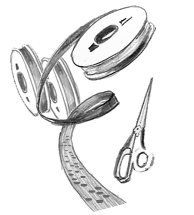 NC paper tape
Furukawa
Particularly, software development was really hard. The person in charge would spend the entire night punching programs into paper tape. That was the only way to create software for the old computers. And if you fed the tape into the computer and there was a mistake, you'd correct the source program by cutting and pasting the tape.
NC paper tape
Furukawa
Particularly, software development was really hard. The person in charge would spend the entire night punching programs into paper tape. That was the only way to create software for the old computers. And if you fed the tape into the computer and there was a mistake, you'd correct the source program by cutting and pasting the tape.
This meant that the tape quickly got bigger, so recoding new tape took ages.
You then converted that into machine language and fed that into ROM*. But computers weren't as advanced as they are now, so there was no way to quickly delete the previous data and rewrite it again. You had to expose it to ultraviolet light for a long period to delete and rewrite the previous data. Rewriting the ROM was also really hard work repeating all these procedures.
And if you needed to correct the program while you were doing that, you had to redo the whole thing from the paper tape. That's why we ended up having no time to sleep.
*ROM: Read-Only Memory
Through his unstinting effort, the Chairman grew the company into a global corporation in the space of a single generation.
Every word conveyed his enormous enthusiasm for the art of "monodzukuri" and I got the impression of someone who was extremely straightforward and sincere. Now, listening to his stories again, I am reminded once more that the products we take for granted are only possible thanks to the creativity, action, and effort of the people who develop them.
He also took the time to explain to the interviewer the Loran machining method, using a model to illustrate his explanation, as well as interspersing humorous comments into the interview as he took through the ins and outs of his story.
One comment he made really impressed me was: "Our work is to build tomorrow."








